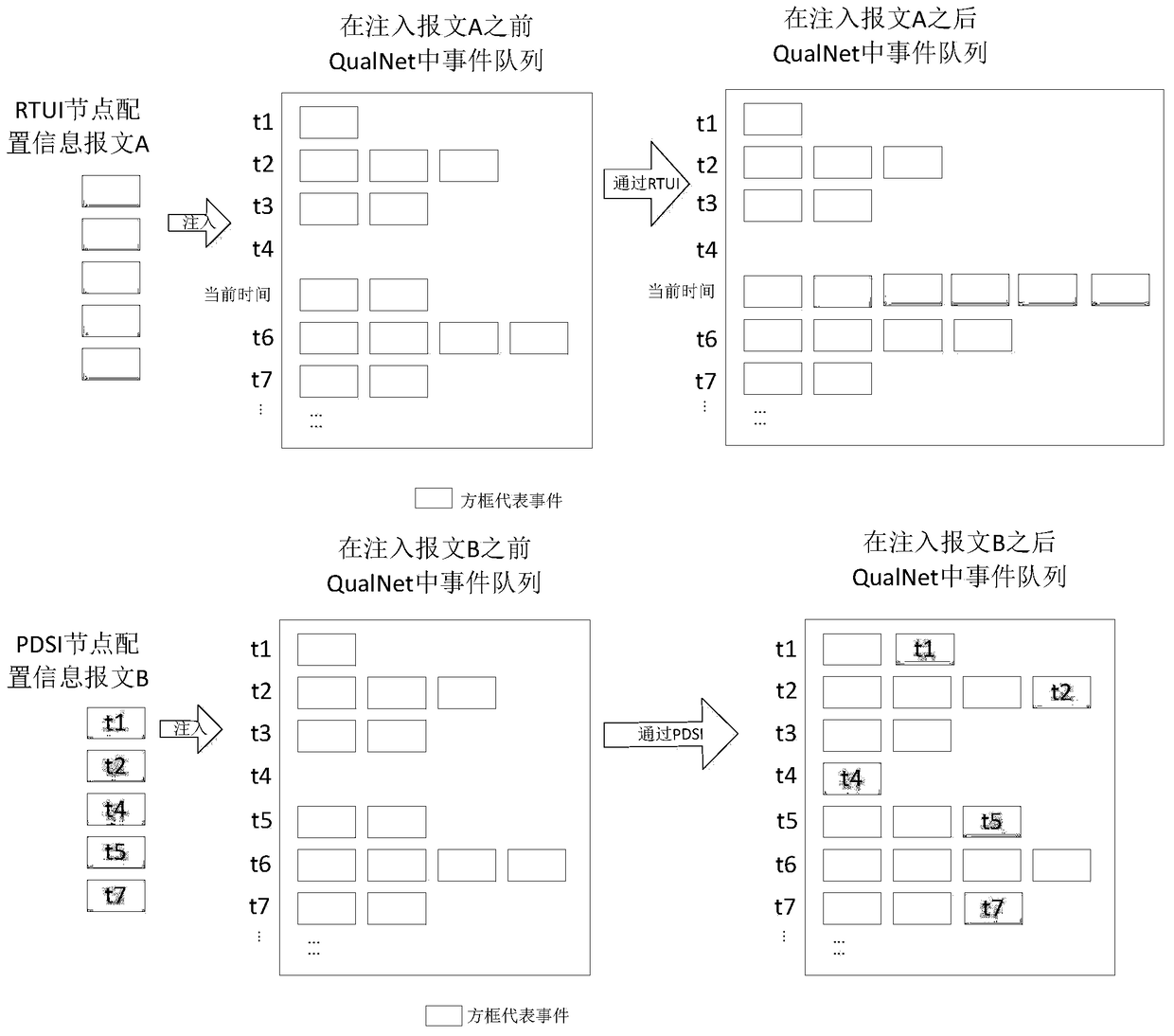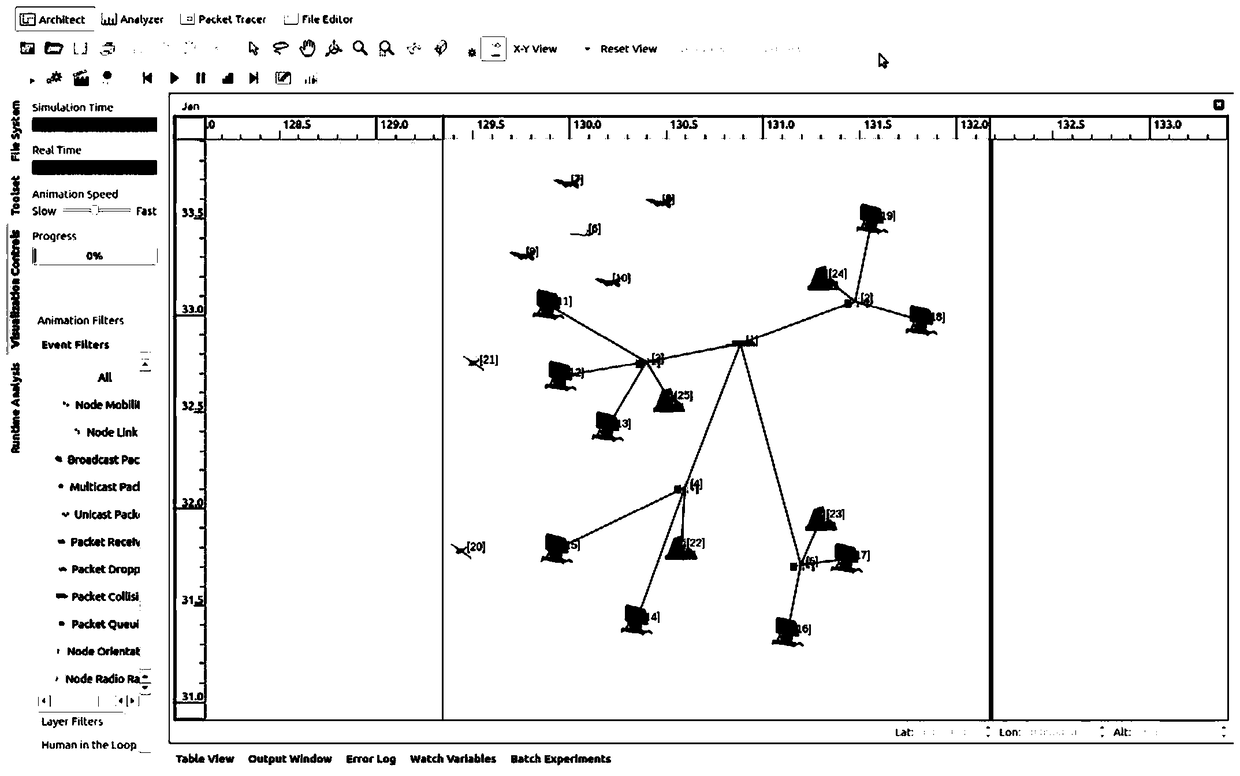A qualnet-oriented simulation scene node information timing modification method
A technology for simulating scene and node information, applied in the field of network simulation, it can solve the problems of inability to realize dynamic modification, batch timing modification, etc., and achieve a more scalable effect
- Summary
- Abstract
- Description
- Claims
- Application Information
AI Technical Summary
Problems solved by technology
Method used
Image
Examples
Embodiment 1
[0055] After the simulation initialization, modify the parameter information of node 12 and node 1 on the external program according to Table 1 and Table 2, respectively, and send them to QualNet. Then the simulation starts, Table 1 changes the radar working parameters of node 12 by the external program; Table 2 changes the Link16 working parameters of node 1 by the external program.
[0056] Table 1 Radar operating parameters
[0057] parameter name
parameter value
scan cycle
1000ms
transmit power
1000w
15dB
Pulse wavelength
10m
System loss
1dB
Noise Figure
1dB
receiver bandwidth
1MHz
anti-jamming factor
30dB
beam width
10
Minimum Recognizable Signal-to-Noise Ratio
5
time
20s
[0058] Table 2 Link16 communication parameters
[0059]
[0060]
[0061] The simulation results show that the working parameters of node 1 and node ...
Embodiment 2
[0074] After the simulation initialization, modify the simulation node parameter information in the external program according to Table 3, and send it to QualNet. Then the simulation starts, and Table 3 changes the network parameters of node 2 for the external program.
[0075] Table 3 Change dynamics of configuration parameters of node 2
[0076] time
Node 2 configuration parameters change dynamically on external programs
0
simulation start
T1
node 2 down
T2
Node 2 Y-coordinate axis changes from 900 to 600
900
simulation end
[0077] At the beginning of the simulation, configure the parameters of node 2 in the simulation scene according to Table 1. The simulation results show that node 2 is closed at T1, the communication between nodes 1-5 is disconnected, and the external program receives the parameter modification success message. At T2, node 2 The coordinates of the corresponding changes, and the external program r...
Embodiment 3
[0083] After the simulation initialization, modify the simulation node parameter information in the external program according to Table 4 and send it to QualNet. Then the simulation starts, and Table 4 changes the network parameters of different nodes at different simulation times for the external program.
[0084] Table 4 External program changes the network parameters of different nodes at different simulation times
[0085]
[0086] Modify the parameters according to Table 4. At the beginning of the simulation, nodes 1-5 are connected to each other. When the simulation progresses to T1, it is found that the communication between nodes 1-5 is disconnected, and the communication between nodes 1-5 is restored until T2; to be simulated When the time goes to T3, it is found that the coordinates of nodes 1, 2, and 3 have changed accordingly, and until T4, the coordinates of nodes 1, 2, and 3 have returned to their original positions. At the simulation time of T1, T2, T3, and ...
PUM
 Login to View More
Login to View More Abstract
Description
Claims
Application Information
 Login to View More
Login to View More - R&D
- Intellectual Property
- Life Sciences
- Materials
- Tech Scout
- Unparalleled Data Quality
- Higher Quality Content
- 60% Fewer Hallucinations
Browse by: Latest US Patents, China's latest patents, Technical Efficacy Thesaurus, Application Domain, Technology Topic, Popular Technical Reports.
© 2025 PatSnap. All rights reserved.Legal|Privacy policy|Modern Slavery Act Transparency Statement|Sitemap|About US| Contact US: help@patsnap.com



